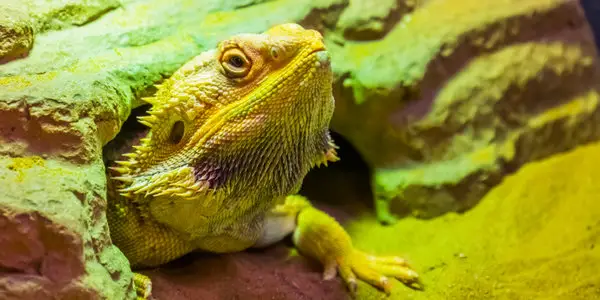Calcium is vital to the growth, development, and overall health of a bearded dragon. The mineral aids in skeletal formulation, muscle contraction, blood clotting, and mineralization of the bones, among other functions.
In its absence, the lizard is likely to suffer from various detrimental health conditions, including metabolic bone disease.
To avoid the severe effects of calcium deficiency in bearded dragons, most pet beardie owners put extra measures to ensure that the lizard gets enough calcium.
Such efforts include providing foods with a calcium to phosphorus ratio above, proper UVB light, Vitamin A, Vitamin D3 supplements, calcium supplements, and gut loading insects with calcium-rich foods.
Although well-meaning, such actions can make the beardie suffer when it takes too much calcium. It leads to a condition known as hypercalcemia.
Below, we will explore more on hypercalcemia in bearded dragons, its causes, signs, and more to help you as the pet owner know how to avoid it or detect it early enough and thus provide your pet with ultimate living conditions.
What Is Hypercalcemia in Bearded Dragon?
Hypercalcemia is a medical condition in bearded dragons that results from excess calcium intake. It can make the pet sick and even lead to death in extreme cases.
In addition, it affects the absorption of other essential nutrients and minerals such as zinc, iron, and phosphorus into the bearded dragon’s bloodstream.
The condition is more common with bearded dragons with over-exposure to UVB light in their enclosures. A beardie needs Vitamin D3 to absorb calcium.
Therefore, calcium overdose occurs when there is an overdose in Vitamin D3 to facilitate calcium over absorption. Without Vitamin D3 over intake, hypercalcemia is less likely to occur.
An inverse condition where the bearded dragon has calcium deficiency is known as hypocalcemia. It is more common among captive bearded dragons than hypercalcemia. Both conditions negatively affect the lizard and should, thus, be avoided.
Hatchlings, baby bearded dragons, and the aged ones are at a higher risk of hypercalcemia than the other moderately aged and adult bearded dragons.
Calcium overdose also has more severe effects on them, and their health deteriorates much faster when they suffer from hypercalcemia.
Signs of Hypercalcemia in Bearded Dragons?
1. Lethargy
A bearded dragon can become lethargic for various reasons, including calcium overdose. Your pet will act lazy and generally exhibit reduced movement and activity in the cage.
Unlike laziness, where the bearded dragon becomes active after a few hours or days, a lethargic beardie will remain inactive and have minimal movement for a prolonged duration.
2. Constipation
A healthy beardie will have frequent and consistent bowel movements. Constipation makes this less frequent because the beardie cannot pass stool effectively.
It is often coupled with a loss of appetite and is one of the initial signs of calcium overdose in bearded dragons.
3. Poor Mobility
Hypercalcemia leads to muscle calcification. It refers to a condition where bone tissues form within the beardie’s muscles leading to the hardening and weakening of the muscles.
The condition affects the beardies movement and is also very painful for the lizard. Your bearded dragon will have difficulty walking and climbing.
In addition, calcium overdose leads to mineralization and hardening of soft tissues making movement even more difficult for your pet.
4. Other Signs
In addition to the above, other signs of calcium overdose in bearded dragons include bloody stool, closing the eyes frequently, lack of appetite, avoiding the basking area, and any other heat source.
These signs are not unique to hypercalcemia in bearded dragons. They may also indicate other underlying conditions.
However, a combination of several of them shows a high likelihood that your pet lizard has too much calcium in its body.
Should you notice a couple of the above signs, immediately take your pet lizard to a vet. The professional will assess the health status of the lizard and verify the underlying problem.
In addition to performing blood tests, the vet may also ask you questions to gather a detailed history of the bearded dragon’s diet and husbandry.
How to Treat Hypercalcemia in Bearded Dragons?
Effective treatment needs correct and accurate diagnosis. As such, it is best to take your bearded dragon to a professional for examination if it shows signs of calcium overdose.
The professional may perform a physical exam on the reptile and blood tests to ascertain that the bearded dragon is suffering from hypercalcemia.
Although fatal in severe cases, early detection makes it possible to treat hypercalcemia effectively. Below are a few of the most effective and commonly used methods of treating hypercalcemia in bearded dragons.
With mild cases of hypercalcemia, the vet will recommend a diet specific to the beardie. The diet aims to regularize the calcium levels in the bearded dragon’s blood.
Further, the vet might recommend giving fewer or no supplements to the beardie for a specific time. It is crucial to adhere to the recommendation and take your pet for review once the period is over.
When hypercalcemia is severe, the vet might recommend medication that will help control calcium levels in the bearded dragon. The drug might also correct some of the signs of the beardie’s hypercalcemia, such as constipation.
Another treatment method is the discontinuation of any multivitamins and supplements that contain Vitamin D3.
The vitamin plays a significant role in hypercalcemia in bearded dragons. Reducing its intake will help reduce the amount of calcium the beardie absorbs into the bloodstream.

How to Prevent Hypercalcemia in Bearded Dragons?
We have seen hypercalcemia’s signs, effects, and treatment options in bearded dragons. Sadly, calcium under-dose also has a detrimental impact on the reptile.
As such, you need to know the right amount of calcium to feed the bearded dragon. Doing so ensures that the beardie lives an optimally healthy life.
Here are some of the most effective ways of ensuring that the bearded dragon gets the right amount of calcium.
1. Adhere to the Feeding Schedule
One of the key causes of calcium over and under-dose is over or under supplementation of calcium supplements.
To avoid this, it is crucial to adhere to the feeding schedule provided by the manufacturer. It may vary from one brand to another depending on the calcium contents in the products.
In addition, the amount of calcium supplements to be given to a baby bearded dragon is different from that of an adult.
Knowing the precise amount to give the lizard is one of the most effective ways of preventing hypercalcemia and hypocalcemia in these reptiles.
In general, bearded dragons other than hatchlings don’t need to take calcium daily.
Below is a summary of the recommended calcium feeding schedule for bearded dragons.
| Bearded Dragon Life Stage | Frequency |
| Hatchlings | Every day |
| Juveniles | 3- 4 times weekly |
| Adults | Once weekly |
| Reproductively mature females | 3- 4 times weekly |
| Adults with sufficient UVB Light | Once per 2 weeks |
2. Consult a Vet
Bearded dragons do not need regular visits to the vet as much as other pets such as cats and dogs do. However, it is good to take the beardie to the vet for assessment, especially if you just got it.
The vet will assess various nutritional components in the beardie and recommend the ideal amount of calcium you should give the beardie.
In addition, such an assessment provides room for you further to understand the perfect diet specific to your beardie.
3. Provide Proper UVB Conditions
UVB light helps a bearded dragon with vitamin D3 synthesis. A vet will also guide you on the right UVB conditions for your pet beardie.
Bear in mind that these conditions vary primarily depending on their age. Such knowledge will help you avoid overexposing your pet to UVB light and thus prevent Vitamin D3 over intake.
Another preventive measure is to avoid calcium supplements with Vitamin D3 if you are already providing your pet with proper UVB conditions.
What Happens When a Bearded Dragon Has Too Much Calcium?
Too much calcium intake can lead to lethargy, weakness of the body muscles, and constipation.
In prolonged cases, the beardie might die due to calcium overdose. The condition is known as hypercalcemia.
Can Bearded Dragons Get Calcium Deposits?
Yes, bearded dragons can get calcium deposits. It is a rare occurrence that requires the bearded dragon to also have excess Vitamin D3.
In turn, this makes the beardie absorb excess amounts of calcium into the blood, and some of the excess calcium causes calcification of the reptile’s muscles. In the end, the bearded dragon’s muscles grow weak, affecting its overall body functioning.
Can You Give A Reptile Too Much Calcium?
Yes, it is possible to give a reptile too much calcium. It is a rare scenario and occurs less frequently compared to cases of providing a reptile with insufficient amounts of calcium.
Too much calcium can affect the reptile’s overall quality of life, and you should adhere to the proper diet and supplements to avoid calcium overdose.

Conclusion
Hypercalcemia can occur from well-meaning intentions by the bearded dragon owner. The importance of giving a beardie enough amounts of calcium is well understood among most beardie pet owners.
However, you should be on the lookout for signs of hypercalcemia which occurs when the beardie absorbs too much calcium.
Lethargy, constipation, closed eyes, and poor motion are some of the signs of this condition. If your bearded dragon is diagnosed with hypercalcemia, do not panic, the disease is treatable.
A professional will guide you on an effective diet, habitat conditions, and medication to aid in the recovery of your beloved beardie.